Last Updated on September 5, 2022 at 4:50 pm
UTI S&P BSE Low Volatility Index Fund is an open-ended scheme tracking the S&P BSE Low Volatility TRI. In this review, we evaluate the pros and cons of investing in this fund currently in its new fund offer period.
Regular readers may be aware that we have proclaimed the benefits of low volatility investing for a few years now. See Nifty Low Volatility 50: A Benchmark Index to watch out for (July 2016). We publish a low volatility + momentum stock screener each month and also update the performance of the direct equity portfolio based on this idea.
Now with UTI S&P BSE Low, Volatility Index Fund investors have a way to passively track a low volatility index. Although an index fund is more expensive than an ETF (ICICI has a low volatility based ETF), price-nav deviations particularly during periods of market stress determine returns more than cost. See ETFs vs Index Funds: Stop assuming lower expenses equals higher returns! Also, see ICICI Prudential Nifty Low Vol 30 ETF FOF Review.
There are several considerations investors should be aware of before taking UTI S&P BSE Low Volatility Index Fund seriously. Let us get to that after we look at the performance of the underlying index.
Join 32,000+ readers and get free money management solutions delivered to your inbox! Subscribe to get posts via email! (Link takes you to our email sign-up form)
🔥Want to create a complete financial plan? Learn goal-based investing? Exclusive access to our DIY tools? Increase your income with your skills? Use this link to enjoy massive discounts on our robo-advisory tool & courses! 🔥
The S&P BSE Low Volatility Index has 30 companies from the S&P BSE LargeMidCap with the lowest volatilities, as measured by standard deviation. Each stock cannot have a weight of more than 5%. So this naturally acts like an equal-weight index reducing concentration risk. In contrast, the Nifty 100 Low Volatility 30 index limits itself to the large cap universe. This does not however mean the two indices are significantly different in terms of risk or reward.
This is the growth over the last 10 years.
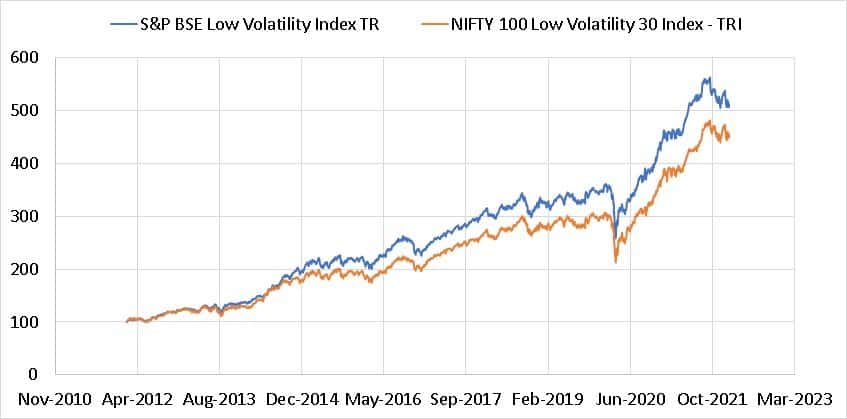
These are the 5Y rolling returns. There is not enough history to discern a difference between the two indices.
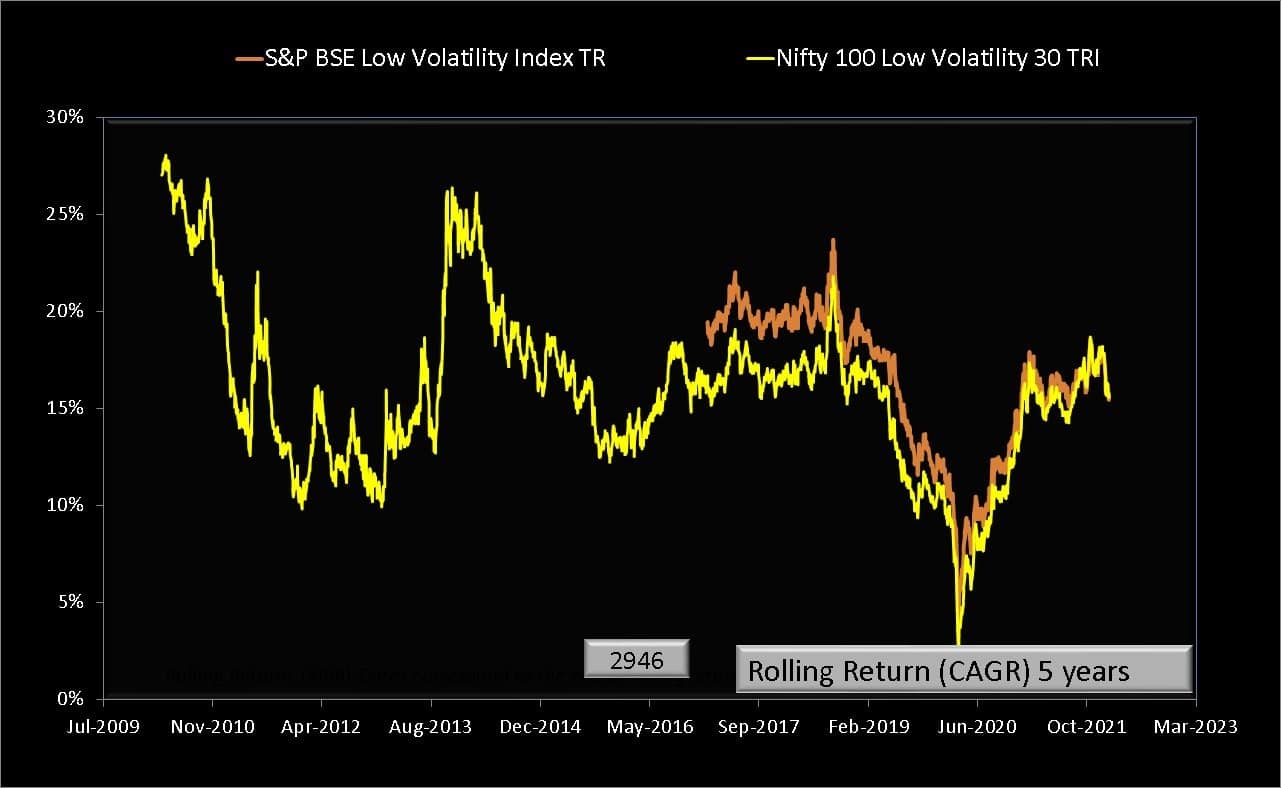
S&P BSE Low Volatility Index TR the index tracked by UTI S&P BSE Low Volatility Index Fund is compared with S&P BSE LargeMidCap TR and S&P BSE SENSEX (TR)over the last ten years

It may look rosy when viewed like this, we need to look at the rolling returns. We can only do so over 5 years as there is not enough history available in the public domain.
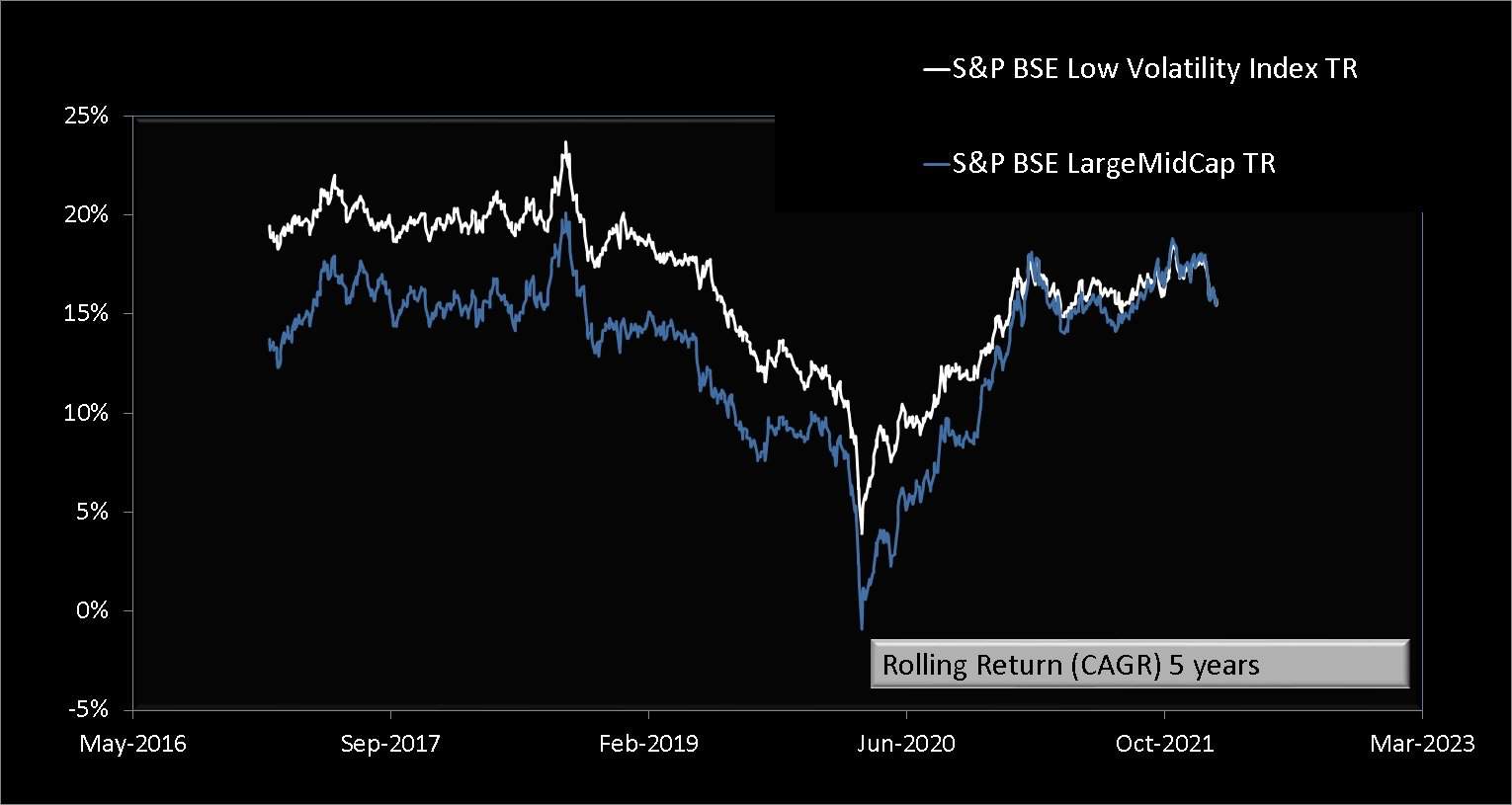
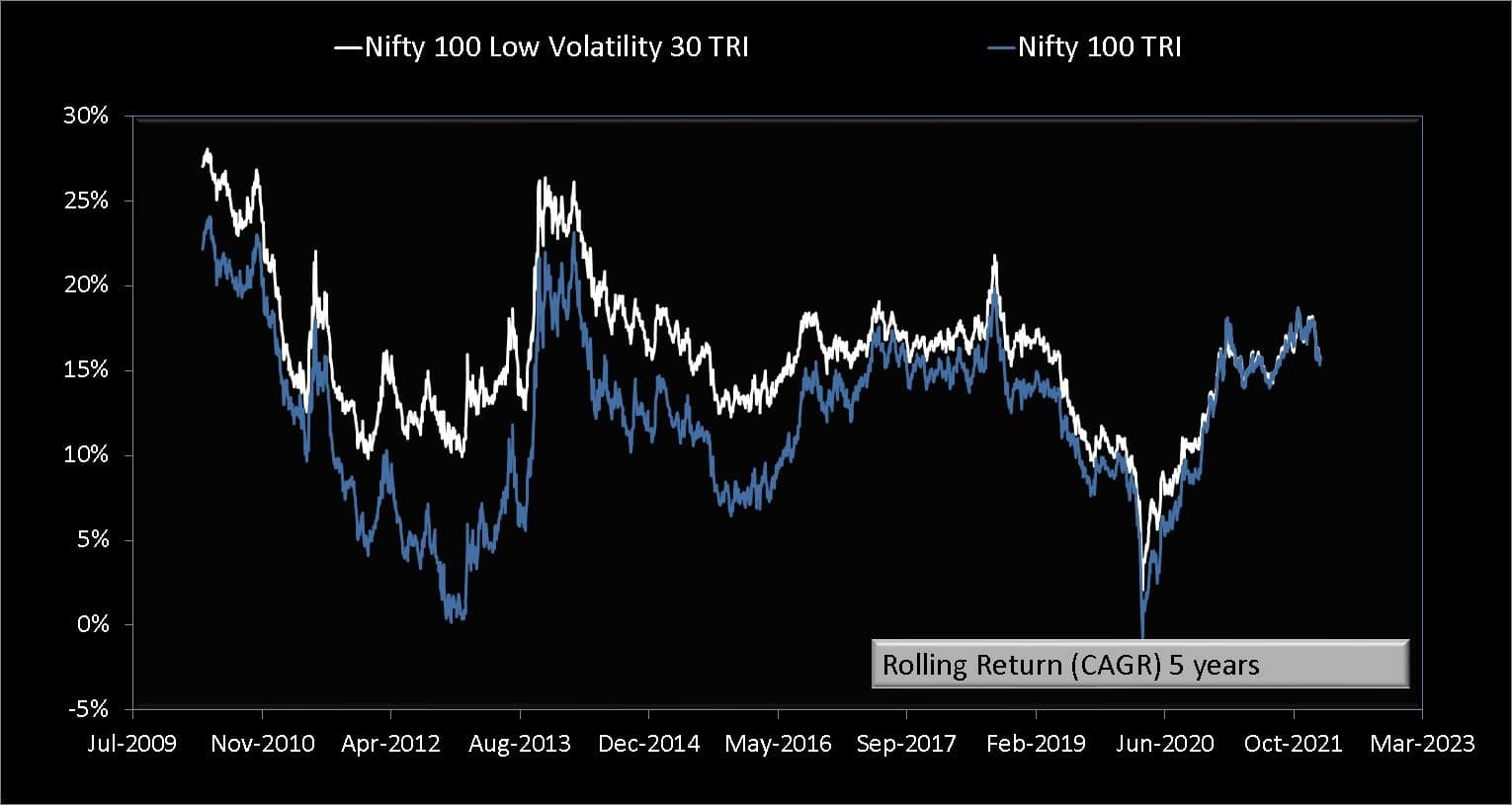
In both cases, the low volatility has typically outperformed the base index except over the last few months as noted earlier – Nifty 100 Low Volatility 30 vs Nifty 50: Return difference at an all-time low
This underperformance is a first for the low volatility indices. This means the past performance of low volatility as a “factor” or as an “return anomaly” may not be as robust in the future. Considering the fact that UTI S&P BSE Low Volatility Index Fund is likely to be 2-4 times more expensive than a Nifty or Sensex index, the margin of underperformance will be higher.
Unexpected underperformance is a common problem with all factor indices. They have been “designed” to produce good results with past data but there is not enough market history in India to check if an idea works consistently well. Also, see: Data Mining in Index Construction: Why Investors need to be cautious
That said, among all the factors, lower volatility than the base index is a simple guarantee. This means the return of the low volatility index per unit risk taken is likely to be higher than that of the base index.
Stated in other words, the low volatility index has a reasonable chance of producing better risk-adjusted returns than the base index. The fund management fee will however play a crucial role here as mentioned above.
The 5Y rolling standard deviation of S&P BSE Low Volatility Index TR is compared with Nifty 100 Low Volatility 30 TR and S&P BSE LargeMidCap TR and S&P BSE SENSEX (TR)
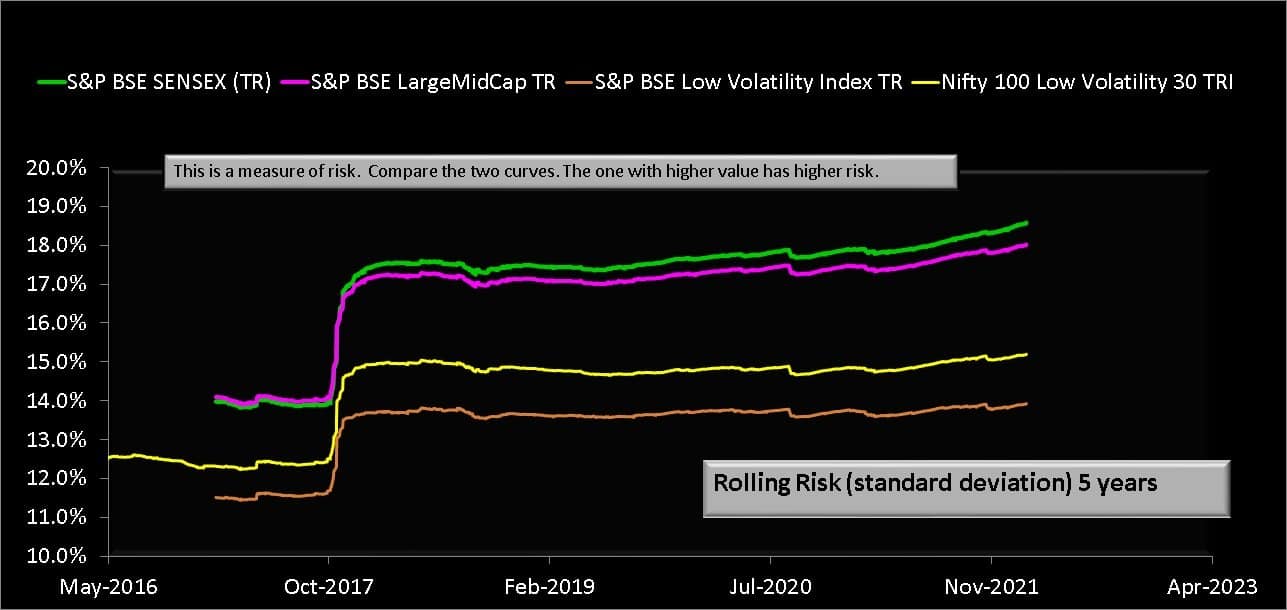
The lower volatility (and therefore better risk-adjusted returns before expenses) is thus a guarantee. When the index is placed into an open-ended fund, its expense ratio, in- and outflows therefore tracking error will determine the user benefit
This is the case with the US low volatility index too. The returns are not different from S&P 500 but the lower volatility is guaranteed and therefore better risk-adjusted returns. Data is available here: Low volatility stock investing – Does it work? Higher returns at lower risk?
Compared to the momentum factor which chases after higher risk in the hope of higher absolute reward, the low volatility factor chases lower volatility in the hope of higher absolute reward.
In the former case, if the higher risk does not pay, we are left with a poor outcome – lower absolute return and lower risk-adjusted return at a higher fee. In the latter case, if the lower risk does not produce higher absolute returns, it at least has a reasonable chance of producing better risk-adjusted returns (subject to tracking error and fees). Also see: UTI Nifty200 Momentum 30 Index Fund: Who should invest?
Now, volatility or the daily up and down price movement is only one way to look at risk. What about a fall from a maximum aka drawdown?
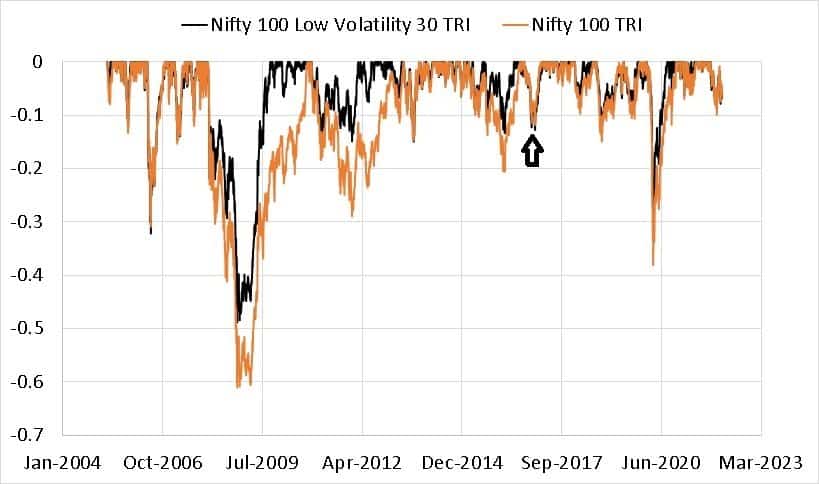
The low volatility index does well on this count too, although a lower drawdown wrt the base index is not a guarantee (the arrow is one such instance).
Investors must clearly understand that UTI S&P BSE Low Volatility Index Fund is a passively managed active mutual fund with the Nifty or Sensex or the S&P BSE LargeMidcap as its benchmarks. That is the index curator chooses the stock basket (different from a market index) based on a set of rules and not the fund manager. This is of course true for all factor-based or quant-based passive funds. The curator may change these rules if the past performance does not extrapolate into the future!
Will I invest? I was on the lookout for a fund in my retirement portfolio as it is too heavy on Parag Parikh Flexicap (the intake stoppage has come at a good time for me!). See Portfolio Audit 2021: How my goal-based investments fared this year.
I have always preferred Quantum Long Term Equity for its low volatility. With UTI S&P BSE Low Volatility Index Fund I get that at a lower fee and lower fund manager risk. So from that point of view, this offering from UTI seems like a good fit for me, perhaps even a replacement for the Quantum fund.
Please note that I have the means to evaluate portfolio volatility and drawdown as a time series (daily data published annually in December as ‘audits’). I have always valued low volatility and risk-adjusted returns above bare returns. Therfore I have taken a chance and invested in this fund. (See 2021 audit linked above for other portfolio holdings).
This is a decision based on personal circumstances. Kindly do not take this as a recommendation to invest. If anything, it is a recommendation to consider your circumstances carefully.
It is only a chance because, as mentioned above, a good index packaged into an ETF or fund can still be a bad index fund. Also, Siva from Facebook group Asan Ideas for Wealth has warned several times that low volatility does not mean low drawdown and its returns are also cyclic. To quote him: “when US (Global) interest rates rise Low Vol will lose, high beta will gain and when rates fall, Low Vol gains and high beta falls”
So far, we have not seen such a correlation with interest rates for the Indian scenario but it is still early days and the future could be different. At the very least we can apply the freefincal axiom, “nothing works forever”. So the past performance shown above may mean little when we start investing in UTI S&P BSE Low Volatility Index Fund (or any other fund for that matter). And it will be an expensive chance to take with this.
Five years from now, it may so happen that the absolute return of UTI S&P BSE Low Volatility Index Fund is lower than that of the S&P BSE LargeMidCap.
Question is, am I willing to take this chance? Am I at a stage in life where I can afford to take it? My answer (based on my personal circumstances and preferences) is yes. I took a chance and invested in Parag Parikh Flexicap during its NFO period so this will not be the first silly decision I have made (at that point in time no one could have predicted its future performance).
We recommend that investors interested in UTI S&P BSE Low Volatility Index Fund evaluate its position in their portfolio and invest only if necessary. I am considering it only because there is a place for it in my retirement portfolio.
In summary, UTI S&P BSE Low Volatility Index Fund is an expensive choice only for those who appreciate the past performance disclaimer, and the value of risk-adjusted returns and do not expect higher than market returns at all times. Low volatility investing is only for those who appreciate that returns are in hindsight and risk in real-time (the journey).

Use our Robo-advisory Tool to create a complete financial plan! ⇐More than 3,000 investors and advisors use this! Use the discount code: robo25 for a 20% discount. Plan your retirement (early, normal, before, and after), as well as non-recurring financial goals (such as child education) and recurring financial goals (like holidays and appliance purchases). The tool would help anyone aged 18 to 80 plan for their retirement, as well as six other non-recurring financial goals and four recurring financial goals, with a detailed cash flow summary.
🔥You can also avail massive discounts on our courses and the freefincal investor circle! 🔥& join our community of 8000+ users!
Track your mutual funds and stock investments with this Google Sheet!
We also publish monthly equity mutual funds, debt and hybrid mutual funds, index funds, and ETF screeners, as well as momentum and low-volatility stock screeners.
You can follow our articles on Google News

We have over 1,000 videos on YouTube!

Join our WhatsApp Channel



- Do you have a comment about the above article? Reach out to us on Twitter: @freefincal or @pattufreefincal
- Have a question? Subscribe to our newsletter using the form below.
- Hit 'reply' to any email from us! We do not offer personalised investment advice. We can write a detailed article without mentioning your name if you have a generic question.
Join 32,000+ readers and get free money management solutions delivered to your inbox! Subscribe to get posts via email! (Link takes you to our email sign-up form)
About The Author
 Dr M. Pattabiraman (PhD) is the founder, managing editor and primary author of freefincal. He is an associate professor at the Indian Institute of Technology, Madras. He has over 13 years of experience publishing news analysis, research and financial product development. Connect with him via Twitter(X), LinkedIn, or YouTube. Pattabiraman has co-authored three print books: (1) You can be rich too with goal-based investing (CNBC TV18) for DIY investors. (2) Gamechanger for young earners. (3) Chinchu Gets a Superpower! for kids. He has also written seven other free e-books on various money management topics. He is a patron and co-founder of “Fee-only India,” an organisation promoting unbiased, commission-free, AUM-independent investment advice.
Dr M. Pattabiraman (PhD) is the founder, managing editor and primary author of freefincal. He is an associate professor at the Indian Institute of Technology, Madras. He has over 13 years of experience publishing news analysis, research and financial product development. Connect with him via Twitter(X), LinkedIn, or YouTube. Pattabiraman has co-authored three print books: (1) You can be rich too with goal-based investing (CNBC TV18) for DIY investors. (2) Gamechanger for young earners. (3) Chinchu Gets a Superpower! for kids. He has also written seven other free e-books on various money management topics. He is a patron and co-founder of “Fee-only India,” an organisation promoting unbiased, commission-free, AUM-independent investment advice.Our flagship course! Learn to manage your portfolio like a pro to achieve your goals regardless of market conditions! ⇐ More than 3,500 investors and advisors are part of our exclusive community! Get clarity on how to plan for your goals and achieve the necessary corpus no matter the market condition!! Watch the first lecture for free! One-time payment! No recurring fees! Life-long access to videos! Reduce fear, uncertainty and doubt while investing! Learn how to plan for your goals before and after retirement with confidence.
Increase your income by getting people to pay for your skills! ⇐ More than 800 salaried employees, entrepreneurs and financial advisors are part of our exclusive community! Learn how to get people to pay for your skills! Whether you are a professional or small business owner seeking more clients through online visibility, or a salaried individual looking for a side income or passive income, we will show you how to achieve this by showcasing your skills and building a community that trusts and pays you. (watch 1st lecture for free). One-time payment! No recurring fees! Life-long access to videos!
Our book for kids: “Chinchu Gets a Superpower!” is now available!


Must-read book even for adults! This is something that every parent should teach their kids right from their young age. The importance of money management and decision making based on their wants and needs. Very nicely written in simple terms. - Arun.Buy the book: Chinchu gets a superpower for your child!
How to profit from content writing: Our new ebook is for those interested in getting a side income via content writing. It is available at a 50% discount for Rs. 500 only!
Do you want to check if the market is overvalued or undervalued? Use our market valuation tool (it will work with any index!), or get the Tactical Buy/Sell timing tool!
We publish monthly mutual fund screeners and momentum, low-volatility stock screeners.
About freefincal & its content policy. Freefincal is a News Media organisation dedicated to providing original analysis, reports, reviews and insights on mutual funds, stocks, investing, retirement and personal finance developments. We do so without conflict of interest and bias. Follow us on Google News. Freefincal serves more than three million readers a year (5 million page views) with articles based only on factual information and detailed analysis by its authors. All statements made will be verified with credible and knowledgeable sources before publication. Freefincal does not publish paid articles, promotions, PR, satire or opinions without data. All opinions will be inferences backed by verifiable, reproducible evidence/data. Contact Information: To get in touch, please use our contact form. (Sponsored posts or paid collaborations will not be entertained.)
Connect with us on social media
- Twitter @freefincal
- Subscribe to our YouTube Videos
- Posts feed via Feedburner.
Our publications
You Can Be Rich Too with Goal-Based Investing
 Published by CNBC TV18, this book is designed to help you ask the right questions and find the correct answers. Additionally, it comes with nine online calculators, allowing you to create custom solutions tailored to your lifestyle. Get it now.
Published by CNBC TV18, this book is designed to help you ask the right questions and find the correct answers. Additionally, it comes with nine online calculators, allowing you to create custom solutions tailored to your lifestyle. Get it now.Gamechanger: Forget Startups, Join Corporate & Still Live the Rich Life You Want
 This book is designed for young earners to get their basics right from the start! It will also help you travel to exotic places at a low cost! Get it or gift it to a young earner.
This book is designed for young earners to get their basics right from the start! It will also help you travel to exotic places at a low cost! Get it or gift it to a young earner.Your Ultimate Guide to Travel
 This is an in-depth exploration of vacation planning, including finding affordable flights, budget accommodations, and practical travel tips. It also examines the benefits of travelling slowly, both financially and psychologically, with links to relevant web pages and guidance at every step. Get the PDF for Rs 300 (instant download)
This is an in-depth exploration of vacation planning, including finding affordable flights, budget accommodations, and practical travel tips. It also examines the benefits of travelling slowly, both financially and psychologically, with links to relevant web pages and guidance at every step. Get the PDF for Rs 300 (instant download)